Abstract
There is increasing use of digital technologies in urban planning, including in the generation of designs and the participative side of planning. We examine this digital planning by reporting on the application of an experimental online participatory platform in the regeneration of a London housing estate, enabling reflection on participation processes and outcomes. Drawing on lessons learned, the paper synthesises a conceptual representation of online participation and a relational framework for understanding the participatory platform and its context. We subsequently develop a ‘matrix of participative space’, building on Arnstein’s ‘ladder of participation’, to present a two-dimensional framework of online participation, identifying cases of ‘participative deficit’ and ‘democratic deficit’. We conclude with implications for future digital participation in urban planning and design.
1. Introduction
Urban planning is increasingly enabled by digital technologies, encompassing both the digital generation of designs—from computer-aided design to recent developments in three-dimensional (3D) modelling—and the participative side of planning, involving the consultation and communication of plans on the internet for public display and feedback [1,2,3]. In some cases, the digital component is simply a direct analogue for the traditional means—a virtual model instead of a physical model, or electronic documents rather than paper plans pinned to display boards. However, in other cases, digital formats allow new ways of engaging with development planning, affording opportunities that were not previously considered possible or viable.
Public participation and information sharing are being revolutionised by web-based technologies. Social media applications such as Facebook, Twitter and Instagram, alongside web-based gaming such as Second Life and the rise of mobile devices, are providing new means and platforms for online interaction. In the realm of planning, such platforms can facilitate community organisation and engagement in decision-making processes (see [2,4,5,6,7]) as part of a general prerogative for ‘smart’ and inclusive cities [8,9].
The ability for mass collaboration is one distinct aspect of emerging technologies. Most notably, this occurs in the form of crowdsourcing and crowdfunding, which have no respective equivalents within conventional participatory processes; that is, the ability for groups of people who are otherwise strangers to associate and generate ideas and/or funds for new developments or facilities in a particular locality. The ability of these ‘virtual networks’ of collaboration to influence planning decisions may depend, at least for the foreseeable future, upon how they manifest themselves through concrete actions and connections, as well as how they may be embedded in existing governance structures [10]. These emerging digital tools also raise a number of associated questions: Who is involved in the using these technologies? Who is enabled or excluded? What kinds of urban development can be facilitated? At what stage within the process are they integrated, such as at the outline or detailed design phases? Who ultimately makes the final decisions, and hence, who has the balance of power between, for example, local authority planners, development professionals, and local residents? Ultimately, these questions serve to highlight how public participation in the digital era can be positioned within a spectrum spanning from external control to self-organisation in planning decision making, superseding previous linear understandings of engagement [11,12,13]. In redefining our conception of participation as a consequence of the rise of digital collaborative networks, broad reflections are induced regarding the planning system itself, what it could or should do, how, and by whom.
This paper explores public participation in the digital age by reporting on the application of an experimental online participatory platform—Incubators of Public Spaces—to regeneration proposals at a housing estate in London (The project involved partners from four countries, with application to three cities (London, Torino, and Brussels) https://incubatorsofpublicspacescomblog.wordpress.com/about-2/ (accessed on 24 January 2024). The technical development and operation of the model and platform, and the application to the other case study cities, are reported elsewhere (e.g., [14,15])). This platform is innovative in combining a 3D model with online facilities that allowed the public to input their own designs for the regeneration of the estate’s courtyards, to comment and, in principle, vote on these, and subsequently generate local design solutions. The experimental application of this system can shed light on some of the possibilities for improved participatory processes through the use of digital technology whilst also highlighting practical difficulties in the resolution of more stubborn problems associated with public participation.
This paper outlines the merits of public participation in planning to contextualise the emergence of digital participation. The role of digital technology in public participation is discussed, highlighting comparative examples to the Incubators platform and, more broadly, relevant conceptual models of participation. The nature of the Incubators platform is then explained, followed by a description of the case study setting, the Pollards Hill housing estate. The Incubators’ interface, engagement, and implementation are then detailed, highlighting the public participation outcomes. After discussing the successes and problem faced in the Incubators’ participatory process, a number of lessons are provided to inform digital participation. Subsequently, a new extended framework that develops Arnstein’s ‘ladder’ for the digital age is presented in the form of a ‘matrix of participative space’, with concluding comments addressing issues in the application of digital technology in the planning system.
2. Theoretical Background
2.1. Public Participation in Planning
Encouraging public participation in the planning process has, at least in principle, long been a central concern for planning practitioners and applied with varying degrees of success [3,13,16,17]. The reasons supporting a participatory planning approach are manifold. Firstly, participatory planning could help to address concerns over the ‘top-down’ nature of post-war planning by enabling local people to be involved in the development of decision making. This harnessing of local knowledge would assist in understanding the needs of an area and inform placemaking [17,18]. This, in turn, may instil a sense of achievement and empowerment amongst participating citizens out of which further community engagement may emerge [19,20]. Developing the social capital of local communities therefore represents an outcome rather than solely a method to be used [18,21,22,23,24], with their engagement building confidence in decision-making and participatory processes [25]. In sum, public participation can both shape urban development outcomes to respond to local needs and build the capacities of citizens to plan their neighbourhoods.
However, the rationale for public participation can present an idealised view of participatory processes and ignore the practicalities of facilitating community involvement. Public participation processes are commonly dominated by the most vociferous (and time-rich) individuals, who pursue their own interests, with potentially divergent and conflicting interests not easily reconciled [26,27]. Additionally, many distrust the participation process, believing that their input will either be ignored or used to affirm predetermined development objectives [28]. Also, many disadvantaged citizens are ‘hard-to-reach’ given that they may be time poor, have limited awareness of the norms of participatory practices, or lack knowledge and/or confidence to involve themselves [27,29,30]. Furthermore, many may simply fail to envisage how future development will impact them, whilst others, for various reasons, would rather decisions be delegated to politicians or professional practitioners [29].
Participation may also be limited or compromised by the way the scope or parameters of the participation process are set up, for example, in the selection of a geographical boundary from within which citizens chosen to participate are included or a restriction on the potential development agenda. The motivation for such limits can be political but may also reflect the practicalities of process management [31] and could include the desire to ensure that those who will be most impacted by potential development are involved in the participatory process and, perhaps of more contention, that consultation relates only to development proposals that are considered financially viable.
Perhaps the most influential conception of public engagement in planning processes is Arnstein’s ‘Ladder of Citizen Participation’. Arnstein’s ‘ladder’ (Figure 1) provides a guide to understanding the influence of citizens in decision making, with progression up the rungs reflecting increasing levels of citizen participation [11]. While this classic conception of participation has inspired many variants (see for example [32]), there does not seem to exist a single agreed contemporary version, a matter of particular note given the digital possibilities for organisation outside of conventional participatory processes. Additionally, the ladder as originally conceived could be said to both overestimate the likelihood of planners today attempting the more unsavoury actions of placation, therapy and manipulation, while simultaneously overestimating the citizen’s willingness to participate. An opportunity therefore arises to revisit and build upon this conception to reflect the emerging digital era.
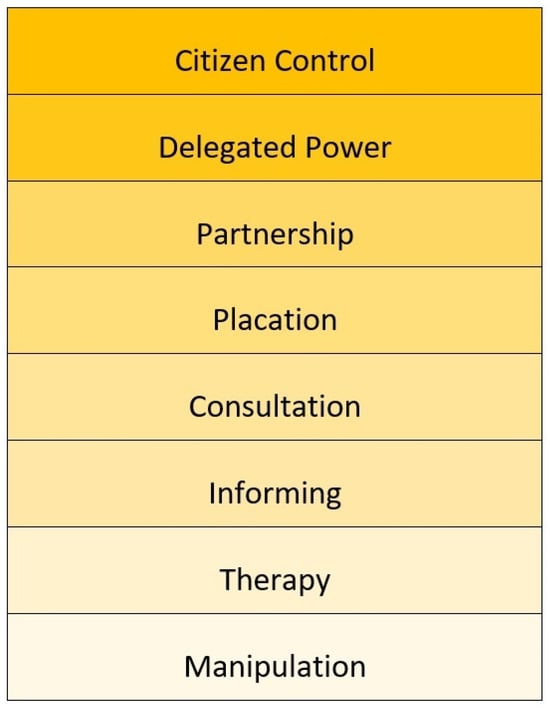
Figure 1.
Arnstein’s ‘Ladder of Citizen’s Participation’ expressed as a vertical ranking of seven steps (after [11]).
2.2. Digital Technology for Public Participation
Digital planning innovations are a diverse body of work and can constitute technological breakthroughs, for instance, in data analytics, building information modelling, and augmented reality; others are social innovations in which existing technologies are applied in ingenious ways to the planning and development process [33,34,35,36]. Digital technology in site choice, design and participation is a developing field. By its nature, planning and development often take place over numerous years, involving multiple agencies, interested parties and residents concerned with development at a city scale through to streetscape and hyperlocal changes. Due to the often contentious nature of development, digital participation will commonly supplement rather than replace the more traditional workshops and public events; that said, its use and uptake has accelerated due to the COVID pandemic [37].
A critical aspect of digital planning innovations is the potential for users to directly engage with the subject matter. Indeed, digital technology can enable users to engage online to varying degrees with a variety of applications to create and share content, as is commonplace on social media platforms. Figure 2 provides one such interpretation of the various levels of engagement through online digital media; this implies a vertical asymmetry whereby the higher up one goes, the greater the degree of an individual’s contribution but the fewer people there are engaging at that level. Other interpretations refer to the ‘power law of participation’ or characterise the different roles in terms of ‘the four Cs’ (consumers, commenters, contributors, and commentators) or ‘the four Ls’ (linking, lurking, learning, and leading) [32]. Whatever the labels, and however many levels are identified, the implied vertical asymmetry, with the number of participants at each level in principle quantifiable, seems to be an important dimension of participation that is notably absent from Arnstein’s ladder.
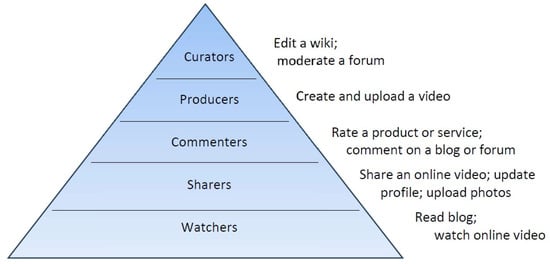
Figure 2.
‘Pyramid’ of online media engagement. Source: Adapted from CorpGov.net. https://www.corpgov.net/2015/02/video-friday-triple-feature-shareholder-engagement/ (accessed on 24 January 2024) [38].
One can immediately sense an echo of Arnstein’s ladder (Figure 1) in the sense of the upward direction implying increasing user involvement or control. That said, Figure 2 reminds us that online users may not all aspire to invest high levels of time and effort in their own engagement, such that citizens may not aspire to match the decision-taking commitment of municipalities. Karadimitriou et al. [39] provide a useful summary of the risks associated with the use of crowdsourcing platforms and their limitations, which are similar to the limitations of ‘analogue’ public participation methods discussed in Section 2.1 in this paper. They highlight that ‘although crowdsourcing has a lot of potential to efficiently increase participation and could potentially lead to more effective outputs, neither of the two outcomes is guaranteed’. Specifically on the issue of geography and equity, Griffin and Jiao [40] report that ‘In some contexts, smartphone applications can help reach lower-income communities, even when compared with in-person meetings’ whereas Mihelj et al. [41] found that ‘Rather than helping increase the diversity of audiences, online access seems to reproduce, if not enlarge, existing inequalities’.
Online platforms are obviously not of a uniform nature, and therefore, it is important here to present leading examples of digital innovation in a participatory context to demonstrate contrasting functionality and contextualise the Incubators project within emerging opportunities for citizen engagement.
The first example, StickyWorld, is an online platform that has been used in participation processes to collect ideas, consult and review proposals, and present and explain outcomes [42]. Within the StickyWorld platform, the consultation organisers used a slideshow alongside a town map, 360-degree photography, and StickyWorld’s ‘sticky note’ feature to solicit feedback and ideas from users by enabling them to pin virtual comments to locations pertaining to issues such as the need for pedestrian crossings and bike racks at popular locations.
Another example of digital participation is Smarticipate, which enables citizens to access, verify and contribute to data about their city, allowing them to better support the planning decision-making process. This can be undertaken through various elements of a selected site being highlighted to attract comments via an online board.
There are various two-dimensional examples of online commenting, discussion, and site-viewing platforms, with many supported by photographic supplementation. However, less common at the scale of an individual site is a 3D view, which is more widely used for large-scale city visions. In this context, the Incubators system has the potential to provide an innovative, multi-faceted approach combining a 3D model and an online participative platform.
When the research was instigated, there was a need to develop a better understanding of the implications on participation in urban regeneration, of the use of an online 3D design-capable crowdsourcing platform which could develop implementable design solutions.
3. Materials and Methods
3.1. The Project and Site Context
The Incubators of Public Spaces project was set up to understand how new technology could be integrated into a planning system to facilitate distributed decision making in the self-organisation of places through the development of urban design software within an online crowdsourcing platform [15].
At the core of the project was the 3D modelling of a locality. Urban design features could be incorporated and manipulated by a platform user within this 3D model, allowing them to create their own designs and publicly share and comment on other users’ 3D designs. The project team developed and adapted the software for implementation at the Pollards Hill housing estate in the London Borough of Merton. The estate comprises low-rise high-density dwellings, including three storey terrace houses set around partly enclosed green space ‘courtyards’ (Figure 3a,b). Originally a council housing scheme, many of the properties are now in private ownership, but overall, the site is managed by the Moat Homes housing management company, who also manages collective concerns of the site on behalf of all residents, whether tenants or owner-occupiers.
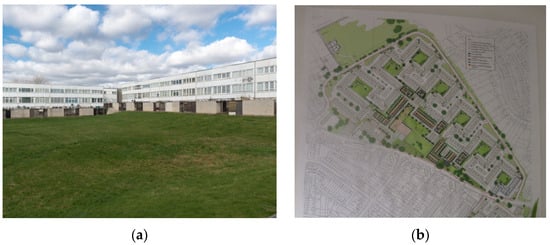
Figure 3.
(a) General view of a courtyard, Pollards Hill. (b) Public display poster of Pollards Hill master plan, showing the seven courtyards featured in the project (Credits: Richard Timmerman; project team).
The Incubators project involvement coincided with redevelopment of the estate (Figure 4). This already had an ongoing conventional consultation process; the Incubators platform was therefore complementary to this ongoing process; in effect, the Incubators system was an optional, experimental exercise for public feedback, allowing it to be more ambitious in offering design intervention options than it might otherwise have been if restricted to a formal consultation on a specific proposal—bearing in mind the potential of 3D planning tools for widening participation but also their limitations.
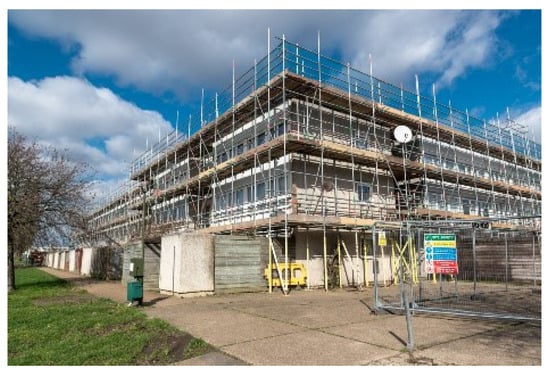
Figure 4.
A housing block undergoing refurbishment, mid 2017 (Credit: Richard Timmerman).
3.2. The 3D Model
The platform’s primary engagement element was the 3D model which allowed the user to select design interventions (such as trees, benches, sports equipment) from a predetermined set, and place them in a generic trial courtyard, subject to some plausible constraints (e.g., trees cannot be placed on a sports court). The process of how these decisions came to be made is detailed elsewhere [15]. The following section therefore focuses on the nature of the platform as implemented and released for public use.
The Incubators 3D model (Figure 5) could be manipulated by a series of tools and applications via menus and a palette of design interventions (Figure 6). The model was developed in SketchUp, a 3D modelling computer program for a range of drawing applications. SketchUp allowed the model to be developed with a distinct visual style, one that allowed a concentration on the spaces around the buildings. Minimalist styling also allowed the model to be compatible with the Incubators web-based platform.

Figure 5.
The Monmouth Court/Lindsey Court Area of Pollards Hill in Sketchup, showing low level of detail.
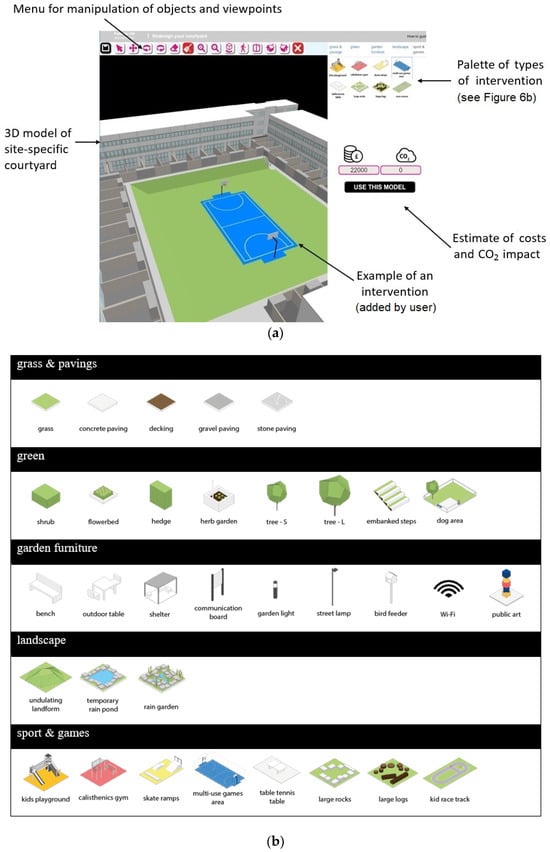
Figure 6.
(a) Screenshot of the model of a courtyard. (b) The typology of design interventions.
Julin et al. [43] define three partially overlapping categories for communicating 3D urban models—3D geographical information systems, building information modelling, and computer graphics. The Incubators model falls into the computer graphics category, developed as a visual tool rather than a spatial information system. Presenting the 3D model in this manner allowed it to be computationally ‘lightweight’, for visualisation and distribution online without the need for specific plugins (additional software) within the Incubators platform.
The interface was common to all project case study cities, though the set of allowable interventions to be used at Pollards Hill was specifically developed in collaboration with the Moat housing management company and the landscape architects. Indeed, the whole scope of the design exercise had to fit with the needs and circumstances of the Pollards Hill courtyard refurbishments. In order to determine the design interventions (as shown in Figure 6) that could be chosen, two constraints were highlighted through discussions with Moat: firstly, the costs of the elements with regard to their purchase, installation, and operation; and secondly, the local circumstances, such as the site topography and flood risk areas, which constrained installation. The choice of design interventions available to users was also informed by Moat’s prior knowledge of residents’ attitudes towards certain features, such as their desire for skate ramps and natural play spaces. However, choosing the design interventions to be subject to the digital participation process inevitably inhibits the potential for users to create innovative proposals.
The design interventions provided were generic rather than specific in their appearance (Figure 6). This meant that, for example, specific bench shapes or species of tree were not offered. This was to help ensure that the main engagement with the platform was with the general design of the courtyard area, while specialist designers (e.g., landscape architects; engineers) would deliver the detailed design and ensure any regulatory and/or contractual compliance. This retains the agency of ‘experts’ in generating the outcomes of participation. In turn, this raises the broader issue as to whether the outcomes of participation are considered indicative and, thus, open to specific articulation and interpretation by experts or blueprints to which all development must conform.
3.3. The Incubators Platform Website
Subject to invitation, as described later, the platform’s website was made available to residents via a password protected landing page leading to a welcome page from which it was possible to view any existing designs as well as proceed to the idea generation stage (Figure 7).
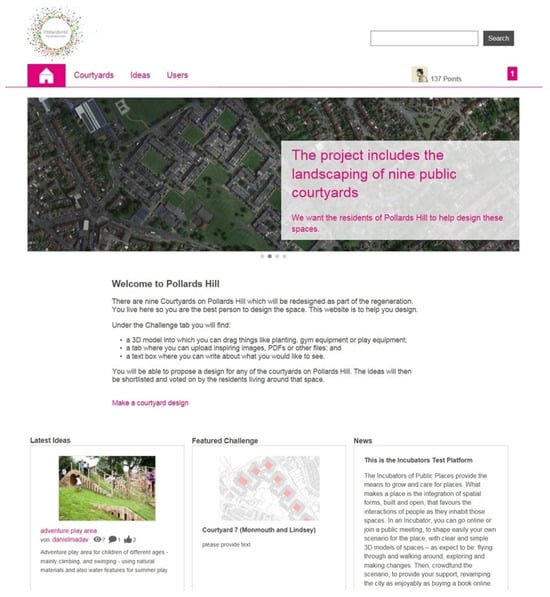
Figure 7.
Screenshot of the Incubators platform welcome page at development/testing stage.
Aside from allowing comments on other users’ contributions, the Incubators platform allowed users to make their own suggestions for proposals using four further methods:
- A simple text entry, allowing users to describe ideas for their courtyard(s);
- Image upload, allowing users to input, for example, photos of a desired feature or an exemplary location;
- An online ‘drawing board’, allowing the use of drawing tools to create a personal dedicated image; this could, for example, allow a user to sketch a solution that could not otherwise be replicated using existing photos;
- The 3D model, allowing the user to add design interventions from a pre-defined set and in an arrangement of their own choosing; to share this on the platform and for other users to be able to edit those designs to make new proposals.
It is possible to regard items 2 to 4 above as innovative new levels of possible participation above and beyond the level of input of textual suggestions found in existing platforms. In particular, we recognise here the ability to create and edit 3D designs as a separate level above merely inputting 2D suggestions. As such, it is possible to refine the ‘pyramid of online media of engagement’ (see Figure 2) to create a new ‘ladder’ of online public participation (Figure 8) (It was later noted that the number of courtyard designs produced was actually greater than the total number of users, and hence, a pyramid would inaccurately represent the volume of outputs at each level of engagement. As such, this updated conceptual approach presents progression stages based upon the attribute rather than quantity of interaction.).

Figure 8.
A seven step ‘ladder’ of online participation in planning decision-making process.
Our new ‘ladder’ echoes both Arnstein’s ‘ladder’ (Figure 1) and the earlier online participation pyramid (Figure 2) given that it culminates with maximum engagement and has commitment at the summit. This does not suggest that the ultimate goal of the user is always to reach the highest level of engagement; rather, the preferred level of engagement is facilitated by the online platform, whilst acknowledging that a user’s engagement may be influenced by the context in which the development project is undertaken.
4. Results
4.1. Platform Participation and Implementation
The Incubators platform was operational from the 11 August 2017 and remained open to use through to the end of September. Four participant groups were invited to use the platform:
- The primary grouping were the estate’s residents, who were invited to participate via a letter that was sent to each of the estate’s households. This decision was principally based on the view that all residents had an obvious interest in the redesigning of the estate’s public realm.
- Pupils from a local school were invited to participate in two workshops that were organised to enable it to reach a relatively large group of potential users and generate sufficient usage on which to reflect. The two sessions involved pupils aged 14 and 15 years old as part of their Information Technology class, enabling the software to be accessed on the school’s computers.
- The Incubators system was demonstrated to members of the public at a number of local events and consultation sessions, enabling them to examine its functionality, albeit with limited opportunity to develop comprehensive courtyard designs.
- Finally, access to the platform was made available to a small group of professionals who were invited to trial use the system and comment on its potential (some responses are reported here: [44]).
The invitation for participation in the platform, notably when determining which residents to engage, did raise issues comparative with the customary public participation process, including questions regarding who has a stake and, thus, a ‘voice’ in public realm decisions. Additionally, the platform also had to reflect the interconnected democratic and technological dimension with regard to the involvement of users. Indeed, defining a constituency for participation involves shaping a technological response, and vice versa, embedding technological ‘rules of the game’ creates participatory constraints. For example, password registration can empower those invited to participate but exclude others and close discussion to those outside the identified constituency.
Overall, there was a reasonable degree of engagement with the platform, albeit somewhat limited with regard to the estate’s residents. Overall, there were 74 users of the platform, generating 143 courtyard designs (see Figure 9 for samples). The user-created courtyard designs used the majority of design interventions in some capacity, with diverse permutations, albeit within constraints of the menu of allowable interventions.
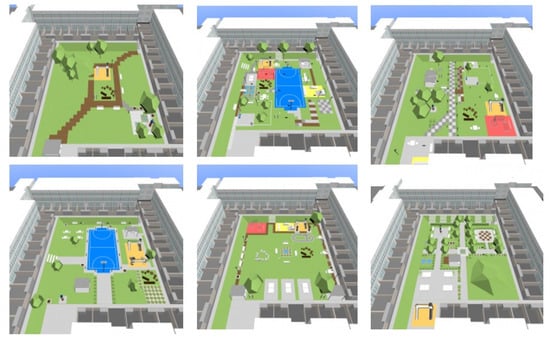
Figure 9.
Screenshots of sample designs.
4.2. Successes
The platform delivered a functional participatory tool that offered the ability to insert and manipulate design features in the 3D model and to present them for public comment. While, arguably, the software operation was not as functionally slick as commercial products, it did allow the ability to ‘fly’ through the site, or rotate the courtyard, at the touch of a finger. As such, it offered the ability to easily navigate a specific development setting and apply design interventions.
The reception by those who fully engaged with the platform was largely positive. Indeed, a number of the users described the ‘entertaining’ and ‘fun’ nature of being in control of the design of the courtyard setting. Whilst it is difficult to offer rigorous conclusions regarding the platform’s appeal given the limits of a singular case study, the feedback received, particularly from the school children already familiar with gaming applications such as Minecraft and SimCity, suggested that the platform cultivated an enthusiasm amongst users about engaging in a project for the planning of their local area. This offers some cause for tentative optimism that such technology can attract a new generation of citizens who more enthusiastically embrace participation.
Finally of note, the platform’s costing facility, albeit only indicative, was viewed positively by many of the users of the software. The interview responses from planning professionals were particularly focused on this aspect, highlighting how this would inform users of ‘real-world’ financial considerations, as well as introduce transparency into the process of decisions around the cost and utility of the chosen design interventions.
4.3. Problems
First, the software itself had some technical limitations. The 3D model did not provide refined graphics and some users felt that its functioning for some operations was somewhat ‘clunky’, thus making the dragging and dropping of some design interventions a bit laborious, although the speed and, hence, perceived manipulability of the software would depend on the hardware being used. This issue may have contributed to limiting resident participation in the platform, although it is hard to qualify such speculation given that no formal user testing was undertaken. Secondly, the project team inferred that the use of the platform may have been impeded by difficulties in understanding the intended engagement process, from the initial login to the creation and commenting on design ideas. However, this issue was overcome in the school participation sessions due to having the opportunity to personally explain the platform’s functioning. Thirdly, some users were disappointed by the scope of design interventions available and the absence of a facility to create new features. Strictly speaking, this is not a limitation of the platform itself but of prerequisites of the planning context.
The main problem with participation in the platform was the limited uptake, which was due to a combination of factors: (i) for project-timescale-related reasons out of the research team’s control, the implementation period commenced during the August holiday period, which limited the opportunity for advertising and promotion; (ii) residents were only approached via a letter from the housing management company, and it is possible that some residents would be generally unresponsive to non-mandatory invitations from this organisation; (iii) the platform, as implemented, was ultimately only offered as an experimental device for expressing design ideas, rather than being part of a formal exercise; (iv) hence, residents could have viewed the tool as not necessarily directly benefiting themselves or might surmise that the ideas inputted would not be acted on. Whilst somewhat a self-fulfilling prediction, they were nevertheless right to conclude as such in this case. Indeed, undoubtedly in part due to the lack of uptake, the design ideas provided were concluded to be non-representative by the management company and, as far as is known, not taken any further.
4.4. Lessons Learned
The lessons drawn from this applied research project somewhat reflect the recommended actions for achieving effective online consultation detailed by Norton [1]. These include, amongst other considerations, the need to communicate the purpose/process of the consultation; avoid complicated processes and functionality; ensure simple registration; create content and visual material that compel people to engage; use online forums to invite comment and discussion; constantly monitor feedback and progress; and ensure that meaningful results are the target [1] (pp. 74–75). It is worth reflecting here on these lessons to inform future online public participation in urban planning.
Firstly, noting the disappointing uptake by residents, it is clear that the use of digital platforms must be supported by adequate advertising, with its purpose and use clearly explained. The success in undertaking this is influenced by the communication networks and community organisation that already exists. Nevertheless, these existing circumstances need to be considered as part of the preparation process, as does the provision of a requisite ‘hard’ infrastructure, such as adequate high-speed internet and computer access and the computer literacy of target users.
This preparation process also requires sufficient time allocation—for the software developers to understand the needs of the client; for building trust between parties; and, for understanding the project organisers’ and partners’ time commitments during and after the period of implementation to run the process and act on results. Also, whilst not necessarily dictating project objectives, the amount of time available to formulate the specific character of an online platform will understandably regulate the scope and parameters of the desired design and planning outcomes.
The project heightened awareness of the difficulty of determining who is allowed to submit design ideas for consideration, as well as who is allowed to comment and, in principle, vote on preferred choices. In essence, this concerns defining stakeholders and, rather than applying universal definitions, the specific characteristics of a site will require an evaluation of any parameters of inclusion. The issue of inclusion also relates to the functioning of the technological tool itself, with the Incubators case highlighting tensions between prescribing design intervention choices and allowing users to express their own ideas. To some extent, this issue is influenced by the point in the planning process when the digital tool is used and the character of the entity to be planned (e.g., site allocations in a development plan; specific regeneration proposals; a neighbourhood plan; and government or private sector-led development). The nature of the design choices will also depend on the legislative and planning policy parameters unless the digital tool is itself being used for shaping policy. This obviously presents intractable problems if citizen self-organisation is considered to be a goal of digital platforms that embed the crowdsourcing of design proposals. Indeed, navigating such parameters will likely require mediation and/or guidance from planning professionals.
Drawing on these lessons enables us to better appreciate the importance of the wider planning context in which the online participatory platform is implemented. Indeed, understanding the platform’s setting involves establishing the ‘contextually set prerequisites’ in a bespoke manner. As Figure 10 shows, these ‘upstream’ considerations required both the definition of the planning challenge and identification of target users prior to the application of the platform. Meanwhile, some considerations (the middle row) required negotiation and joint working between the housing management company and the research team to reach a viable solution to satisfy both project and site residents’ needs. Particularly in these areas, the constraints on one domain could end up imposing on the other, such as where technology could either constrain or liberate creativity or ways of doing local democracy.
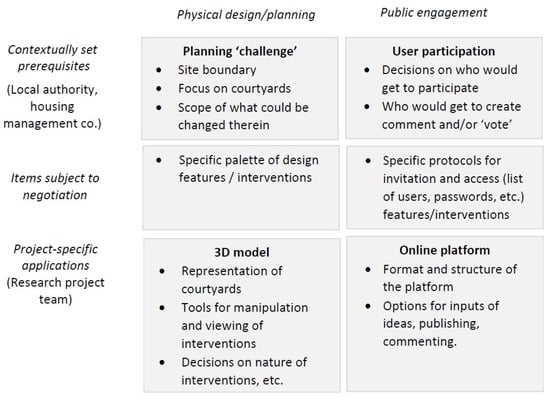
Figure 10.
A framework demonstrating relationships between the Incubators platform and its context of application.
In order for digital participation to be considered legitimate and thus widely accepted by future users, it is vital that the ‘contextually set prerequisites’ are sufficiently defined. As such, the classic challenges of participation remain in that process management and design/planning outcomes are both equally important in the digital age. The Incubators platform was successful in enabling users to create and share design ideas for public comment. However, the ‘prerequisites’ (e.g., relating to prior planning permission) were embedded in the platform, therefore suggesting that such a participatory tool will not of itself provide a self-organising, paradigmatic shift in the creation of the built environment.
5. Discussion
Reflecting on the implementation of the Incubators system and the degree of participation with the platform invites us to consider a new extended framework in which to view the different kinds, digital or otherwise, of engagement and participation. This builds on two previously identified ‘ladders’—that of Arnstein (Figure 1) and that of online engagement (Figure 10, which develops Figure 2). Here, we can recognise that these two models could be complementary and part of the same space of possibility, thus enabling the creation of a ‘matrix of participative space’ with independent dimensions of citizen influence (increasing from left to right) and citizen investment (increasing from bottom to top) (Figure 11) (Within this conceptualisation, the two ‘ladders’ are simplified for mutual consistency. Two of the levels in Figure 8 have been collapsed—reading downwards, rows 2 and 4 in Figure 11 each correspond to two levels in Figure 8—while Arnstein’s categories have been simplified and only run as far as partnership).
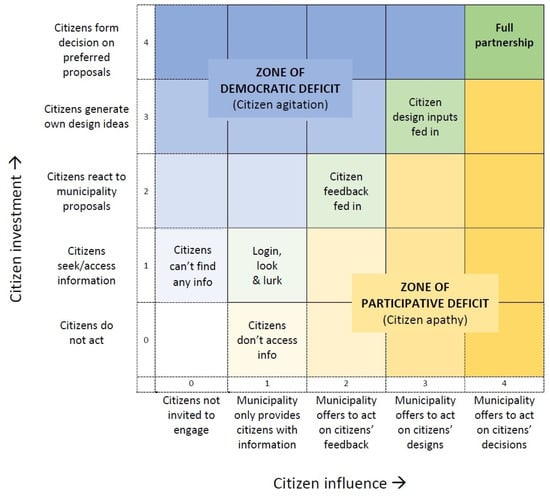
Figure 11.
Matrix of participative space. The zone of participative deficit (citizen apathy; coloured shades of yellow) has a greater degree of participation invited than is actually taken up; the zone of democratic deficit (citizen agitation; coloured shades of blue) has a greater degree of citizen investment offered than is granted influence.
Here, position (0, 0) represents no action either on the part of the citizens or the municipality. Position (4, 4) represents a state of full partnership, where citizens are invited to take part in decision making, and do so. Between these, there are a series of steps in a diagonal formation, representing increasing levels of participation. This could be interpreted as corresponding roughly to an idealised version of Arnstein’s ladder, where the actions of the citizens and authorities are mutually complementary. However, the 2D format of the matrix also throws up two other zones. To the upper left is the ‘zone of democratic deficit’, where citizens pursue levels of participation that are not reciprocated by the authorities. Conversely, to the lower right, we find a ‘zone of participative deficit’ where citizens are offered the chance of participation but where the citizens, for whatever reason, do not engage.
The matrix can be used to identify different processes in participative planning situations. In the case of Incubators, two distinct but mutually reinforcing tendencies occurred. On the one hand, the citizens were invited to contribute designs, but for various understandable reasons, did so in statistically negligible numbers. This would represent position (3, 1). On the other hand, because of the limited response, the designs that were submitted were not directly acted upon. For those that did submit designs, this would be position (1, 3).
The matrix can also be used to locate where the digital dimension has enabled a greater level of participation. The Incubators platform enables a level of sophisticated design generation (and sharing and editing) beyond the normal level of feedback by conventional means, and therefore, if applied in more favourable circumstances, could achieve (3, 3) if not (4, 4), if including the voting/jury facility and with a suitably receptive municipality.
6. Conclusions
This paper has reported on the development and application of an innovative online platform of digital participation in planning. Although the system was experimental with a limited scale of user participation or influence, a number of lessons have been learned (Section 4.4 and Section 5). Here, we highlight three areas of innovation and three implications for future planning.
First, the Incubators platform demonstrates a degree of technical innovation at a level beyond what existing platforms typically offer (as seen in the upper levels of Figure 8) by going beyond textual suggestions to incorporating the 3D modelling and sharing of user-generated designs, within a set of realistic property rights, costs, and design constraints [39,44]. Although these constraints limited the variety of possible solutions somewhat, they increased the implementation potential of the residents’ suggestions.
Secondly, the platform was applied to both self-selecting residents and to computer-literate school children, encountering some of the challenges of traditional participation with the former, while offering a glimpse of the potential for uptake by future generations. For the present, it would seem that a combination of traditional and digital means of participation is required to maximise reach and uptake.
Thirdly, conceptually, our two-dimensional ‘matrix of participative space’ (Figure 11) goes beyond existing linear frameworks (Arnstein’s 1969 ladder [11] and its variants on the one hand and models of digital participation on the other [32]) to suggest a wider ‘participative space’ explicitly highlighting zones of citizen apathy and citizen agitation.
In terms of implications for practice, it would first seem that facilitating a more radical approach, whereby digital participation results in directly agreed online decision making, would likely require a redefinition of the planning process and statutory planning powers; the authority to develop local planning policy and approve formal development proposals currently falls within the remit of local planning authorities. To ensure spatial coherence, self-organisation processes would also need to be cognisant of broader strategic objectives, such as those provided in a local authority area, and to secure political ‘buy-in’. However, self-organisation does not have to be the immediate or ultimate objective of digital participatory tools. Indeed, technological advancement does not have to replace governance and participatory processes but rather can endow us with new tools to improve development outcomes or at least address small public realm improvements which fall outside of the formal planning controls.
Secondly, the project raises further questions about the role of the ‘plan’ and the professional planner and how we should conceive the outcomes of public participation. Are digital participation design outcomes to be considered blueprints to be delivered or indicative proposals to be interpreted by planning professionals? The former would likely diminish the role of the ‘expert’ relative to the latter, with an interpretive role requiring planners to see digital participation within the current system as a communicative process. In this sense, digital participation can support the planner in understanding citizens’ desires rather than being a means to create precise visual representations to which development decisions should conform.
Finally, questions regarding how public participation can be more effective will surely continue given the opportunities emerging with the advancement of digital technology. This is of course not new; indeed, for three decades the case has been made for the development and adoption of digital tools that better support spatial decision making in planning using 3D information. The planning process has, however, been arguably slow to adapt and adopt new technologies, and it is perhaps only now that it is starting to move into a more digitally focused era [45,46].
An Incubators-type platform provides for an immediate and direct participatory process, with the user participation, design generation and feedback phases all potentially undertaken within a short passage of time. It is this direct process, linked into the 3D digital tool, which we would argue creates a unique experiment in participation, using digital tools while keeping central to the aims of participation with rapid feedback. These shorter time horizons will provide more efficient means in which to engage local residents but, as we have found, there are still a number of challenges, old and new, which will require addressing in order to integrate digital participation into a legitimate planning and democratic framework. Nevertheless, we envisage increasing potential as technologies of representation and design improve, as the coming generation of ‘digital natives’ are increasingly likely to use these technologies with ease, and as online tracking and archiving allows enhanced transparency in design sourcing and decision making.
Author Contributions
Conceptualization, S.M., N.K. and A.H.-S.; methodology, S.M., A.H.-S. and N.K.; investigation, D.F. and A.K.; writing—original draft preparation, S.M., D.F. and A.H.-S.; writing—review and editing, S.M., D.F., A.H.-S. and N.K.; visualization, S.M.; project administration, S.M., N.K. and A.H.-S.; funding acquisition, S.M., N.K. and A.H.-S. All authors have read and agreed to the published version of the manuscript.
Funding
This research was funded by Joint Programming Initiative Urban Europe, under grant 414896. The partners of the Incubators of Public Spaces consortium were Politecnico di Torino (coordinator), Innovation Service Network Gmbh, Katholieke Universiteit Leuven, Neurovation Gmbh, University College London, and Turin municipality. The UCL part of the project was funded by the UK Economic and Social Research Council (ESRC), grant ref: ES/M008495/1.
Data Availability Statement
Data relating to the Incubators platform is restricted due to commercial confidentiality (software development).
Acknowledgments
The authors would like to thank other project team members, Richard Timmerman, Giacomo Magnani, Sol Perez Martinez, and Yuerong Zhang, for their contribution to the project; and the team at Moat Homes Limited for collaboration at the Pollards Hill site.
Conflicts of Interest
The authors declare no conflicts of interest. The funders had no role in the design of the study; in the collection, analyses, or interpretation of data; in the writing of the manuscript; or in the decision to publish the results.
References
- Norton, P. Changing forms of consultation. Town Ctry. Plan. 2018, 87, 71–76. [Google Scholar]
- Afzalan, N.; Muller, B. Online participatory technologies: Opportunities and challenges for enriching participatory planning. J. Am. Plan. Assoc. 2018, 84, 162–177. [Google Scholar] [CrossRef]
- Wilson, A.; Tewdwr-Jones, M. Digital Participatory Planning: Citizen Engagement, Democracy, and Design; Routledge: New York, NY, USA; Abingdon, UK, 2021. [Google Scholar]
- Evans-Cowley, J.; Hollander, J. The new generation of public participation: Internet-based participation tools. Plan. Pract. Res. 2010, 25, 397–408. [Google Scholar] [CrossRef]
- Gordon, E.; Schirra, S.; Hollander, J. Immersive planning: A conceptual model for designing public participation with new technologies. Environ. Plan. B 2011, 38, 505–519. [Google Scholar] [CrossRef]
- Ertio, T. Participatory apps for urban planning—Space for improvement. Plan. Pract. Res. 2015, 30, 303–321. [Google Scholar] [CrossRef]
- Falco, E.; Kleinhans, R. Digital participatory platforms for co-production in urban development: A systematic review. In Crowdsourcing: Concepts, Methodologies, Tools, and Applications; IGI Global: Hershey, PA, USA, 2019; pp. 663–690. [Google Scholar]
- Itair, M.; Shahrour, I.; Hijazi, I. The use of the smart technology for creating an inclusive urban public space. Smart Cities 2023, 6, 2484–2498. [Google Scholar] [CrossRef]
- Lee, J.; Babcock, J.; Pham, T.S.; Bui, T.H.; Kang, M. Smart city as a social transition towards inclusive development through technology: A tale of four smart cities. Int. J. Urban Sci. 2023, 27, 75–100. [Google Scholar] [CrossRef]
- Kleinhans, R.; Van Ham, M.; Evans-Cowley, J. Using social media and mobile technologies to foster engagement and self-organization in participatory urban planning and neighbourhood governance. Plan. Pract. Res. 2015, 30, 237–247. [Google Scholar] [CrossRef]
- Arnstein, S. A ladder of citizen participation. J. Am. Inst. Plan. 1969, 35, 216–224. [Google Scholar] [CrossRef]
- Wilcox, D. Community participation and empowerment: Putting theory into practice. RRA Notes 1994, 21, 78–82. [Google Scholar]
- Brownill, S.; Inch, A. Framing people and planning: 50 years of debate. Built Environ. 2019, 45, 7–25. [Google Scholar] [CrossRef]
- Caneparo, L.; Bonavero, F. Neighborhood regeneration at the grassroots participation: Incubators’ co-creative process and system. Int. J. Archit. Res. 2016, 10, 204–218. [Google Scholar]
- Caneparo, L.; Rolfo, D.; Bonavero, F.; Van Reusel, H.; Verbeke, J.; Marshall, S.; Haudson-Smith, A.; Karadimitriou, N. Semantic analysis of public spaces in Brussels, London and Turin living labs: A taxonomy of the interventions. In Urban Living Labs for Public Space: A New Generation Of Planning? Proceedings of the Incubators Conference, Brussels, Belgium, 10–11 April 2017; KU Leuven: Brussels, Belgium, 2017; pp. 101–112. [Google Scholar]
- Natarajan, L. People, plans and places 1: Outlooks on participating. Built Environ. 2019, 45, 5–6. [Google Scholar] [CrossRef]
- Natarajan, L.; Short, M. (Eds.) Engaged Urban Pedagogy: Participatory Practices in Planning and Place-Making; UCL Press: London, UK, 2023. [Google Scholar]
- Natarajan, L. Socio-spatial learning: A case study of community knowledge in participatory spatial planning. Prog. Plan. 2017, 111, 1–23. [Google Scholar] [CrossRef]
- Putnam, R.D. Bowling Alone: The Collapse and Revival of American Community; Simon & Schuster: New York, NY, USA, 2000. [Google Scholar]
- Livingstone, S.; Markham, T. The contribution of media consumption to civic participation. Br. J. Sociol. 2008, 59, 337–351. [Google Scholar] [CrossRef] [PubMed]
- Hudson, B.M. Comparison of current planning theories: Counterparts and contradictions. J. Am. Plan. Assoc. 1979, 45, 387–398. [Google Scholar] [CrossRef]
- Friedmann, J. Empowerment: The Politics of Alternative Development; Blackwell: Cambridge, UK, 1992. [Google Scholar]
- Rydin, Y.; Pennington, M. Public participation and local environmental planning: The collective action problem and the potential of social capital. Local Environ. 2000, 5, 153–169. [Google Scholar] [CrossRef]
- Lane, M. Public participation in planning: An intellectual history. Aust. Geogr. 2005, 36, 283–299. [Google Scholar] [CrossRef]
- Burby, R. Making plans that matter: Citizen involvement and government action. J. Am. Plan. Assoc. 2007, 1, 33–49. [Google Scholar]
- Rowe, G.; Frewer, L. Public participation methods: A framework for evaluation. Sci. Technol. Hum. Values 2000, 25, 3–29. [Google Scholar] [CrossRef]
- Lowndes, V.; Pratchett, L.; Stoker, G. Trends in public participation: Part 2—Citizens’ perspectives. Public Adm. 2001, 79, 445–455. [Google Scholar] [CrossRef]
- McGuirk, P.M. Power and influence in urban planning: Community and property interests’ participation in Dublin’s planning system. Ir. Geogr. 1995, 28, 64–75. [Google Scholar] [CrossRef]
- Brackertz, N.; Zwart, I.; Meredyth, D.; Ralston, L. Community Consultation and the ‘Hard to Reach: Concepts and Practice in Victorian Local Government; Institute for Social Research, Swinburne University of Technology: Melbourne, Australia, 2005. [Google Scholar]
- Smith, G. Neighbourhood planning—Promising more than it can deliver? Town Ctry. Plan. 2018, 87, 28–30. [Google Scholar]
- Wolfinger, R.E. Nondecisions and the study of local politics. Am. Polit. Sci. Rev. 1971, 65, 1063–1080. [Google Scholar] [CrossRef]
- Karsten, A. A Potpourri of Participation Models—Updated. 2012. Available online: https://www.nonformality.org/2012/11/participation-models/#more-2330 (accessed on 14 December 2023).
- Webb, S. Future of Planning: State of the Art Innovations in Digital Planning; Future Cities Catapult: London, UK, 2016. [Google Scholar]
- Batty, M.; Yang, W. A Digital Future for Planning: Spatial Planning Reimagined; Digital Task Force of Planning: London, UK, 2022. [Google Scholar]
- Bouzguenda, I.; Fava, N.; Alalouch, C. Would 3D digital participatory planning improve social sustainability in smart cities? An empirical evaluation study in less-advantaged areas. J. Urban Technol. 2022, 29, 41–71. [Google Scholar] [CrossRef]
- Oloonabadi, S.A.; Baran, P. Augmented reality participatory platform: A novel digital participatory planning tool to engage under-resourced communities in improving neighborhood walkability. Cities 2023, 141, 104441. [Google Scholar] [CrossRef]
- Tewdwr-Jones, M.; Wilson, A. COVID-19 and the rise of digital planning: Fast and slow adoption of a digital planning system. Town Plan. Rev. 2022, 93, 495–518. [Google Scholar] [CrossRef]
- Um, N.H. Antecedents and consequences of consumer engagement in social media. Int. J. Contents 2016, 12, 59–68. [Google Scholar] [CrossRef][Green Version]
- Karadimitriou, N.; Magnani, G.; Timmerman, R.; Marshall, S.; Hudson-Smith, A. Designing an incubator of public spaces platform: Applying cybernetic principles to the co-creation of spaces. Land Use Policy 2022, 119, 106187. [Google Scholar] [CrossRef]
- Griffin, G.P.; Jiao, J. The geography and equity of crowdsourced public participation for active transportation planning. Transp. Res. Rec. 2019, 2673, 460–468. [Google Scholar] [CrossRef]
- Mihelj, S.; Leguina, A.; Downey, J. Culture is digital: Cultural participation, diversity and the digital divide. New Media Soc. 2019, 21, 1465–1485. [Google Scholar] [CrossRef]
- Available online: https://www.n-kesteven.gov.uk/sites/default/files/2023-01/hykeham_consultation_statement_0.pdf (accessed on 8 February 2024).
- Julin, A.; Jaalama, K.; Juho-Pekka, V.; Matti, P.; Johanna, Y.; Vaaja, M.; Hyyppä, J.; Hyyppä, H. Characterizing 3D city modeling projects: Towards a harmonized interoperable system. Int. J. Geo-Inf. 2018, 7, 55. [Google Scholar] [CrossRef]
- Marshall, S.; Hudson-Smith, A.; Farndon, D.; Kourniotis, A. Digital participation—Taking ‘planning’ into the third dimension. Town Ctry. Plan. 2019, 88, 11–14. [Google Scholar]
- Kitchin, R.; Young, G.W.; Dawkins, O. Planning and 3D spatial media: Progress, prospects, and the knowledge and experiences of local government planners in Ireland. Plan. Theory Pract. 2021, 22, 349–367. [Google Scholar] [CrossRef]
- Hudson-Smith, A. Incoming metaverses: Digital mirrors for urban planning. Urban Plan. 2022, 7, 343–354. [Google Scholar] [CrossRef]
Disclaimer/Publisher’s Note: The statements, opinions and data contained in all publications are solely those of the individual author(s) and contributor(s) and not of MDPI and/or the editor(s). MDPI and/or the editor(s) disclaim responsibility for any injury to people or property resulting from any ideas, methods, instructions or products referred to in the content. |
© 2024 by the authors. Licensee MDPI, Basel, Switzerland. This article is an open access article distributed under the terms and conditions of the Creative Commons Attribution (CC BY) license (https://creativecommons.org/licenses/by/4.0/).